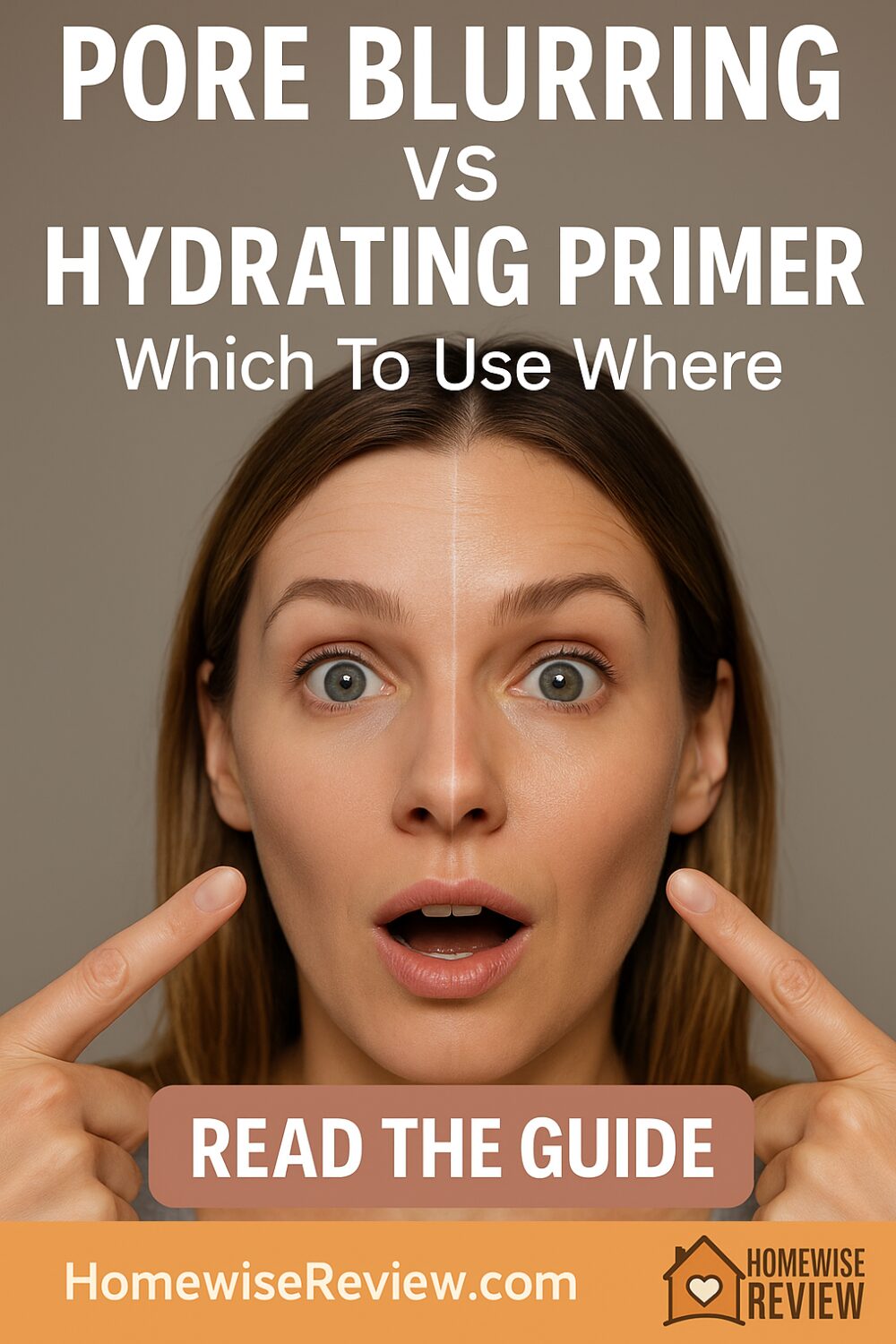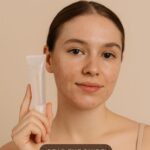
Most people treat primer like a one-and-done step. You grab whatever is trending, smooth it all over your face, and hope for the best. Then you wonder why your nose is still shiny by noon or why your under eyes look dry and creased.
Here is the real situation. Not all primers are trying to do the same job. Pore blurring primers are usually silicone based. They are made to smooth texture, fill pores, and control shine, especially in the T-zone. Hydrating primers are more lotion like. They boost moisture, calm tight or flaky areas, and help foundation sit better on drier parts of the face.
If you use them in the wrong spot, your makeup will fight you. If you learn how to place them, you get smoother skin, less settling, and longer wear without piling on heavy foundation or powder.
This guide walks you through when to use a pore blurring primer, when to use a hydrating primer, how to layer both without pilling, and where to put each one on your face. You will also get quick fixes for busy mornings and longer term habits that make primer work even better.
Let’s build the base the way makeup artists actually map a face, not the way marketing does.
Why this matters for your makeup base
Primer is not just “extra step before foundation.” Primer decides the finish, the wear time, and how much texture shows through. Pick the wrong texture for the wrong area and your skin will tell on you fast.
Pore blurring primers are usually silicone heavy and feel silky or velvety. They sit on top of the skin and create a soft focus effect over visible pores, fine lines, and uneven texture. They can also help slow down breakthrough oils in the center of the face, which helps with slippage. This is why you see a smoother nose, less orange peel texture on the cheeks next to the nose, and less shine on the forehead when people use one.
Hydrating primers act more like lightweight moisturizer plus grip. They have humectants (think water binding) and emollients (think soft, cushioned feel). The goal is not to erase pores. The goal is to stop foundation grabbing onto dry patches or settling in little dehydration lines around the mouth and under the eyes. A hydrating primer also helps makeup look fresher on mature skin or skin that feels tight in colder weather.
So the question is not “Which primer is best.” The question is “What problem are you fixing in this exact zone of your face today.”
If you treat the whole face like oily skin, the outer parts of your face may look flat and cracked. If you treat the whole face like dry skin, your T-zone may look blurred for 30 minutes then shiny for the next eight hours. Zoning solves that.
How to pick and apply each primer step by step
This part is your morning game plan. You can do it in under two minutes once you get used to it.
Step 1. Moisturize first
Primer is not your skincare. Even oily skin needs a light moisturizer under makeup so that primer does not cling in weird patches. Let moisturizer sit for about a minute so it can settle instead of sliding around.
Step 2. Look at your skin in real light
Stand near a window or bright mirror. Do you see visible pores and shine through the center of the face, especially around the nose and forehead. That area is where pore blurring primer belongs. Do you see flaking on the cheeks, chin, or under the eyes. That is where hydrating primer belongs.
Step 3. Use a tiny amount, not a full pump
Pore blurring primer only needs to go where you want to blur. Press, do not rub, a pea sized amount into the areas with visible pores. Think nose, sides of nose, center forehead, center chin. Pressing helps it sit flat instead of rolling up.
Hydrating primer can go a little wider. Smooth a thin layer over cheeks, smile lines, and under the eyes to soften tightness and help makeup glide instead of skipping.
Step 4. Let each set before foundation
Give it 20 to 30 seconds. If you layer foundation too quickly on top of fresh primer, the textures can mix and pill. Letting primer grip first gives you that smooth canvas finish people describe as filter skin.
Step 5. Apply less foundation than you think you need
Once the surface is balanced, you usually need way less base. If you still feel like you have to spackle to get coverage, you may be using the wrong foundation for your skin type, not the wrong primer.
Where each one goes on your face
Instead of thinking “my skin is dry” or “my skin is oily,” think zone by zone. Combination skin is normal. Most faces are combination.
T-zone (forehead, nose, chin)
This is usually where oil shows up first and where pores look largest. This is the best place for a pore blurring primer. Press it into the center forehead, down the nose, and center of chin. You are basically mattifying and smoothing only the high shine zones, not locking down your entire face.
Inner cheeks next to the nose
These areas often have visible pores and a bit of redness. A pore blurring primer can soften those pores so foundation does not highlight them. Tap, do not swipe. Swiping can move product around and create lines.
Outer cheeks and cheekbones
These areas tend to go dull, not shiny, especially on drier or mature skin. A hydrating primer here keeps foundation from catching and looking dusty. It also helps powder blush and bronzer blend without skipping.
Under eyes
This is almost never the place for a pore blurring primer. A pore filling texture under the eye can make concealer grab and crease. Use a hydrating primer or a light hydrating base here instead. The goal is slip plus bounce, not matte.
Smile lines and around the mouth
If foundation settles here by lunch, try patting a tiny bit of pore blurring primer directly into the fold, then let it set. That creates a smoothing film and can slow down creasing. If the area is actually dry and crinkly, go with hydrating primer instead and keep it soft instead of flat.
Jawline
Usually you do not need primer here at all. Save product.
This “map the face” approach is what makes makeup look like skin up close instead of makeup sitting on top of skin.
Quick fixes vs long term habits
There are two tracks here. One is “I have five minutes before work.” The other is “I want my base to sit better every day without fighting me.”
Quick fix:
- Use pore blurring primer only in the very center where you get oil. Do not smear it everywhere. You are spot treating, not frosting a cake.
- Tap hydrating primer only where you see makeup catching, usually cheeks and around the nose in colder weather.
- Skip full face foundation. Dot concealer only where you need it, then blur the edges with a sponge. Set just the T-zone with a light powder if you want longevity.
Long term habit:
- If you are constantly battling shine even with pore blurring primer, you likely need a foundation or skin tint that is made for oily or combination skin through the T-zone.
- If you are constantly patchy even with hydrating primer, your skin barrier might just be thirsty. A richer night cream or a hydrating serum under moisturizer in the morning can make hydrating primer work better, instead of asking primer to fix a deeper dryness issue.
- For mature skin, especially over 40, a hydrating primer around the mouth and on the high points of the cheeks can keep base from cracking through expression lines. Owner feedback often mentions that blurring formulas all over the face can make skin look flat and older, even if it looks smooth in photos. A mix of both textures usually looks fresher.
Troubleshooting common problems
“My primer pills when I put foundation on.”
This usually means too much product or rubbing instead of pressing. Use less. Let each layer set. Press foundation in with a sponge or brush instead of dragging fingers.
“My pores still show.”
Pore blurring primer cannot erase texture that sits higher than the skin surface. Large clogged pores or old acne scarring will still show a bit. You can blur the look, not fully remove it. Pressing the primer into the area instead of wiping helps more of it sit where you need it.
“My makeup looks greasy by 2 p.m. even with pore blurring primer.”
You might be skipping powder or using a very dewy foundation in the T-zone. You can still keep glow on the cheeks and set only the nose and forehead with a light loose powder. You do not have to mattify the whole face.
“My under eyes look dry and crepey.”
This usually means you either used a pore blurring primer under the eyes or skipped hydration there. Switch to hydrating primer under the eye and use less setting powder in that spot.
“My smile lines crack no matter what.”
Try this order: moisturizer, let it sit, a pinpoint of pore blurring primer pressed directly into the fold, let it sit, then only the thinnest layer of base in that area. If you build multiple layers of product on top of a moving spot, it will move.
Final Thoughts
You do not have to pick one side in the pore blurring vs hydrating argument. The real trick is using them like targeted treatment, not paint. Matte down where you shine. Cushion where you crease. That is it.
Once you start zoning your primer, two things usually happen. First, you stop chasing “full coverage” because you realize most of what bothered you was texture or dryness, not actual color you needed to hide. Second, your makeup lasts longer with less upkeep, because you are not forcing one formula to solve every skin issue at once.
If you want makeup that looks smoother in real life and not just in selfies, this is where you start.
See also
If you are still battling shine or visible pores in the center of your face, read Best Primer for Oily Skin next. It breaks down mattifying and pore filling picks that stay put without that tight, chalky look. For anyone noticing fine lines, sag, or foundation slipping around the mouth and jaw, Best Primer for Mature Skin explains what actually helps blur without flattening radiance. You may also want Best Primer for Sensitive Skin if you get redness or stinging from a lot of silicone based blurring products. That one leans gentle and calming so your base does not start irritated.
Once your canvas is handled, the base you choose matters just as much as the primer. Best Foundation for Dry Skin walks through hydrating, flexible formulas that sit nicely on cheeks and smile lines instead of catching and cracking. And if you are 40 plus and your goal is lift without heaviness, Over 40 Makeup Routine That Lifts Without Caking shows placement tricks that keep coverage where you want it instead of everywhere.
FAQs
Do I really need two primers, or can I just buy one “universal” formula?
If your skin is basically the same everywhere, you can get away with one primer. Most people are combo though. Oily through the T-zone and normal to dry on the cheeks is common. In that case, one universal product usually means you are compromising in at least one area.
Can I put hydrating primer on top of pore blurring primer, or will that mess it up?
Layering them on top of each other in the same spot can cause pilling, because you are mixing two different textures that want to sit differently. It is better to zone them. Pore blurring in the T-zone only, hydrating on the outer face only.
Will pore blurring primer clog my pores or cause breakouts.
Most pore blurring primers use silicones to create slip. Silicones themselves are not automatically pore clogging, but heavy occlusion plus not cleansing well at night can trap oil and buildup. Take makeup off fully, and you lower that risk.
My skin is mature and dehydrated, but my nose still gets shiny. Which should I prioritize.
Both, just in different places. Use pore blurring primer only down the center of the face, then use hydrating primer on cheeks, smile lines, and under eyes. This combo usually looks fresher and less heavy than trying to mattify the entire face.
Does setting spray replace primer.
No. Setting spray mostly locks makeup in place at the end. Primer sets up the surface before makeup so that it sits smoother and lasts longer. You can absolutely use both, but they do not do the same job.
Affiliate Disclosure
If you purchase through links on our site, we may earn a small commission at no extra cost to you.




